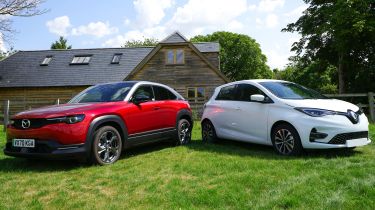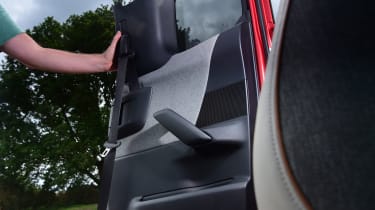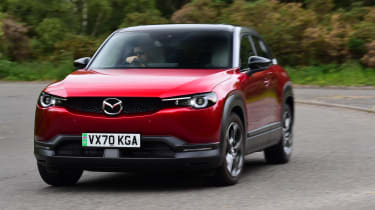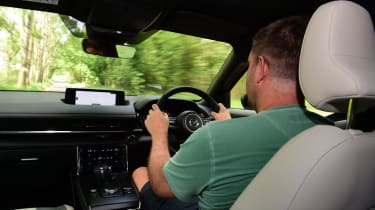Mazda MX-30 GT Sport Tech: Living with it
Mazda's MX-30 electric car has arrived on our fleet – and we're just getting our heads around the out-of-the-ordinary SUV
| On fleet since: | April 2021 |
|---|---|
| List price new: | £32,145 after plug-in car grant |
| Options: | Three-tone metallic paint (£1,800) |
| Mileage to date | 2,630 miles |
| Efficiency to date | 3.8 miles/kWh |
| Problems? | None so far |
Report 3: At one with the car?
Mazda uses the term jinba ittai to describe its ongoing focus on creating cars that involve and reward their drivers. The phrase translates as 'oneness between horse and rider’ and it appeared in the brochure for the first-generation MX-5 roadster back in 1989. The MX-30 is not a sports car, but it shares the famous MX prefix and emerged from the same illustrious Mazda engineering heritage. So does it have a dash of jinba ittai and would any driver really want to become ‘one’ with a small electric SUV?
These weren’t the main questions we wanted to answer with our long-term test of the MX-30. More salient ones about the 124-mile range and the practical value of those willfully odd rear-hinged doors were higher up the agenda. The driving experience is integral to the way we feel about all cars, though, and Mazda clearly wanted owners to feel good about their MX-30s.
Where rival manufacturers have fitted large batteries, chasing headline maximum range figures, Mazda elected to go small and, crucially, light with the MX-30. Merely reading about the 35.5kWh battery is enough to provoke pangs of range anxiety, but those who actually own an MX-30 receive compensation in the way it drives.
Kerb weight is around 1,720kg depending on the model, so this isn’t a particularly light car compared to the equivalent Hyundai Kona Electric (1,610kg) or Vauxhall Mokka-e (1,550kg). It feels light and nimble where it matters on the road, however, and Mazda has kept that weight increase at a reasonable 100-150kg more than its CX-30 petrol-engined sister.
So Mazda may not have 'added lightness' as such, but it has created the impression of it in its first zero-emissions model, ending up with probably one of the best small electric-car driving experiences out there at the moment – and certainly one of the best from a small electric SUV. The MX-30 feels balanced and sharp to respond to steering inputs in a way that connects the driver to the process. It rides well, flowing over good surfaces, although it doesn't completely avoid that electric-car trait of letting you feel bigger bumps a little too much. It’s fun, and that’s not something you’d necessarily say about the competition.
You’ll find better exponents of the effortless, surging acceleration that would see today’s little electric SUVs leave a first-generation MX-5 for dead in a traffic-light drag race, but the MX-30 is still nippy. Plus there’s a great driving position (when you don’t have to allow legroom for rear seat passengers) with lots of adjustment in the seat and steering column.
The slight chink in the MX-30’s driving experience armour is around town, where you'd expect a small electric car with a modest range to excel. The long bonnet makes for a relatively wide 11.4-metre turning circle, far bigger than EVs with purpose-designed platforms like the Volkswagen ID.3 (10.2 metres). That can mean judging the car’s extremities is more difficult than it needs to be.
There’s very little over-the-shoulder visibility to check the blind spots due to the small windows and chunky frames of the rear doors, and that can be disconcerting, even though the area you can’t see in the mirrors is too small for a car to hide in. The visibility issues are mitigated to an extent by the all-round parking sensors and reversing camera that are standard on all versions of the MX-30 and generally make it a challenge to hit anything significant while trying to park the car.
Much like the wider MX-30 package, the way the car behaves purely from a driver’s perspective is a bit of a mixed bag. It’s not a small electric car that fits seamlessly into the urban runabout role, but it doesn’t disgrace itself in the environment where its limited range would suggest it needs to excel. On the open road, the Mazda shines, though, with some of the best and most enjoyable road manners of any electric car at this price – and quite a bit higher, too. The MX-30 is fun to drive and it’s still not possible to say that about many affordable EVs on the market. That’s an achievement in itself – but one you’d have banked on Mazda to get right.
Report 2: Fun while it lasted
For a short time this summer we passed the keys to the long-term MX-30 to our content editor Ellis Hyde, who had a decidedly mixed experience over the course of his three weeks with the car.
While I’d like to think I’ve come to understand the MX-30 a bit better after spending some time and covering a few hundred miles in it, this bizarre car continues to baffle me. Especially because when it wasn’t out on the road, the Mazda spent most of its time parked next to my mum’s own Renault ZOE GT-Line that arrived just over a month ago now. And with the two side-by-side, it seemed the perfect opportunity to pit the MX-30 head-to-head with another similarly priced small electric car I'm much more familiar with.
The MX-30 undeniably has more presence and is the better built of the two. Mazda has done a great job making sure all the touch points throughout the car’s cabin, like the switchgear, gear selector and steering wheel, are solid and covered in high quality materials. Even smaller details like the noise of the MX-30 is better than the ZOE’s, with the Mazda providing the exact sci-fi-esque soundtrack you’d envision from an electric car rather than the more monotone note the ZOE produces at low speeds.
Although, it must be said that for all its positives, there are several unavoidable caveats to the Mazda’s ‘form over function’ design that simply aren’t present in the ZOE. The MX-30’s coach doors, for a start, confounded not just myself, but those I introduced to the car as well. Admittedly, they do add to the rakish style of the MX-30, and parents looking to install car seats will be pleased by the improved access thanks to the lack of a B-pillar.
However, that doesn’t make up for the fact that I repeatedly found issues in tight car park spaces where rear passengers were stuck inside because of the need to open the front doors before being granted access to the back seat. Then, when I was able to open the rear doors, with both sets of doors open the MX-30 creates a boxed-off enclosure against the vehicle in the next space, requiring a series of complex manoeuvres before passengers can escape its grasp.
The MX-30 also quickly falters when you ask a lot of the electric motor. It can handle short bursts of acceleration, from 20-30mph for example, but it noticeably struggles when asked to perform long sprints, like when I was merging into motorway traffic or emerging from junctions onto A-roads. Obviously, neither the ZOE or the MX-30 are capable of the whiplash-inducing acceleration of a Tesla or Porsche Taycan, but the MX-30 did run out of puff sooner than the ZOE when asked for a burst of speed.
Where the Mazda really falls down, however, is when you're driving in a city or town. It’s important to understand that both the ZOE and MX-30 are meant for those living in the city, and these environments are primarily where they’re expected to live out their days. But while the ZOE’s light steering, compact proportions and short overhangs make driving in town a cinch, the Mazda’s long bonnet often made it difficult to place on the road. On a trip down to Brighton this made for some tense moments on the city’s tighter streets.
Weirdly, despite the MX-30’s comically short range, it performed the best of the two cars for me on motorways, as it’s relatively comfortable and feels very stable at higher speeds compared to the Renault.
Ultimately, the MX-30 is a car I’d struggle to recommend. It’s a genuinely enjoyable electric car that is undeniably more engaging to drive than the ZOE and some other EVs at this price point, however, its design, from the doors to the proportions, doesn’t make for a great living experience. Throughout my time with it, I struggled to visualise the person whose life this car would fit into. The Mazda might boast a superior cabin to the Renault, but you have to respect the ZOE’s ‘does what it says on the tin’ approach to electric motoring, not to mention it’s standout 245-mile range.
Report 1: Not your average EV
Mazda is a company with a proud history of doing things that other manufacturers probably wouldn’t. On the face of it, the MX-30 couldn’t be more conformist. It’s a small electric SUV that has arrived at a time when small SUVs are absolutely de rigueur for seemingly every mainstream car brand, and electric power is poised for an explosion in popularity.
Yet the MX-30 isn’t your average small electric SUV and that’s what prompted us to run one on a long-term test. Mazda’s offering is a difficult car to pigeonhole, with its sharp, coupe-like lines, rear-hinged back doors and novel interior trim choices. That’s before we even get to the electric powertrain, which uses a relatively small 35.5kWh battery to achieve a similarly compact 124-mile maximum range. The car has a bigger footprint than rivals like the Vauxhall Mokka-e and Kia Soul EV, but you wouldn’t know that from sitting inside it.
This doesn’t sound like we’re arrowing towards a glowing endorsement of the MX-30, but wait. Could it be that Mazda knows best? We’re at the start of our long-term assessment of the car and even now I can see that once you get past apparent on-paper issues like the range and cabin space to engage with the car itself, you start to warm to it.
It looks good. The three-tone colour scheme on our car – Soul Red metallic with a black roof and dark grey side panels – is an £1,800 option box that many will leave unticked, but it’s very fetching in combination with the latest Mazda styling. There’s a lot of grey plastic cladding on the lower extremities, but generally the MX-30 looks sharp and distinctive.
The pleasing design is carried over inside, where there’s an environmental flavour to the trim choices of cork and recycled fabric. You have to suspect that the light-grey colour scheme isn’t going to hide scuffs and marks brilliantly, but it does look modern and different.
By giving the MX-30 an unnecessarily long bonnet – there's no engine under there, after all – and a coupe-like roofline, you could say Mazda has achieved attractive exterior looks at the expense of rear cabin space. Even for kids, legroom in the rear seats is tight and once the novelty of the rear-hinged doors has worn off, the reality is that they make the MX-30 more practical than a three-door but less so than a full five-door – just as you’d imagine.
In GT Sport Tech trim, our £32,145 car is well equipped to the point that there’s very little on the options list except the various colours and trims. This is definitely not your orthodox small SUV, then, but Mazda’s philosophy with the car seems to have been one of stripping away redundant capacity, providing enough range and enough cabin space for what it sees as the target market.
View the MX-30 as a stylish city car rather than a small family SUV and you get closer to an accurate categorisation. We’ll be the judge of how well it fills the brief as the test continues.




